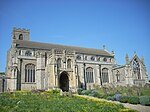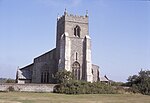Airship N.S.11 crash
1919 disasters in the United Kingdom1919 in England20th century in NorfolkAccidents and incidents involving Royal Air Force aircraftAccidents and incidents involving balloons and airships ... and 6 more
Accidents and incidents involving military aircraftAirliner accidents and incidents caused by weatherAviation accidents and incidents in 1919Aviation accidents and incidents in NorfolkNorth SeaUse British English from March 2018

The Airship NS11 crash was an airship accident which occurred on 15 July 1919. The Royal Air Force (RAF) airship exploded off the east coast of England over the North Sea, killing all nine crew on board.
Excerpt from the Wikipedia article Airship N.S.11 crash (License: CC BY-SA 3.0, Authors, Images).Airship N.S.11 crash
High Street, North Norfolk Cley Next The Sea
Geographical coordinates (GPS) Address Nearby Places Show on map
Geographical coordinates (GPS)
| Latitude | Longitude |
|---|---|
| N 52.951 ° | E 1.043 ° |
Address
High Street
High Street
NR25 7AP North Norfolk, Cley Next The Sea
England, United Kingdom
Open on Google Maps










